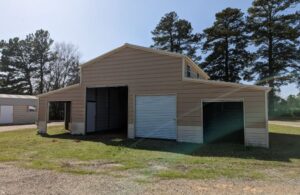
Light Gauge Steel Barns represent a contemporary approach to agricultural structures, offering durability, versatility, and efficiency. Understanding the key features and benefits of these structures can provide valuable insights into why they have become a popular choice for modern farming needs.
1. Material Composition
Light Gauge Steel Barns are constructed using cold-formed steel, which consists of thin sheets of steel formed into structural components. This material is known for its strength, resistance to corrosion, and adaptability to various design requirements.
2. Durability and Longevity
One of the primary advantages of light gauge steel is its exceptional durability. These barns can withstand harsh weather conditions, resist pests, and remain structurally sound over an extended period. This longevity makes them a cost-effective investment for agricultural operations.
3. Customizable Design
Light Gauge Steel Barns offer a high level of customization. Farmers can tailor the design to meet specific agricultural needs, whether it’s for livestock housing, equipment storage, or hay barns. The flexibility in design allows for optimal space utilization.
4. Quick Construction
The construction of Light Gauge Steel Barns is often quicker compared to traditional structures. The prefabricated components and efficient assembly processes contribute to a shorter construction timeline, allowing farmers to benefit from their new structures sooner.
5. Modularity and Expansion
Light Gauge Steel structures are inherently modular, allowing for easy expansion or modification. This is particularly beneficial for agricultural operations that may evolve or expand over time. Farmers can seamlessly add sections or adjust the layout to accommodate changing needs.
6. Energy Efficiency
These barns often come with options for insulation, contributing to energy efficiency. Proper insulation helps regulate temperature, creating a comfortable environment for both livestock and stored equipment. This energy efficiency can lead to cost savings over time.
7. Low Maintenance Requirements
Light Gauge Steel Barns require minimal maintenance. The steel material is resistant to rot, mold, and pests, reducing the need for frequent repairs or replacements. This low maintenance characteristic is a significant advantage for busy farmers.
8. Eco-Friendly Construction
The use of steel in construction aligns with eco-friendly practices. Steel is a recyclable material, contributing to sustainability in building processes. Additionally, the longevity and durability of Light Gauge Steel structures reduce the environmental impact associated with frequent replacements.
9. Cost-Effective Solution
While the initial cost may be slightly higher than traditional barns, the long-term cost-effectiveness of Light Gauge Steel Barns becomes evident. The reduced maintenance, longevity, and energy efficiency contribute to overall savings in operational costs.
In conclusion, Light Gauge Steel Barns represent a modern and efficient solution for farmers looking to enhance their agricultural infrastructure. The combination of durability, customization, and sustainability positions these structures as a forward-thinking choice in meeting the evolving needs of the agricultural sector.
